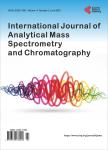Structure Elucidation of a New Toxin from the Mushroom Cortinarius rubellus Using Gas Chromatography-Mass Spectrometry (GC-MS)
Structure Elucidation of a New Toxin from the Mushroom Cortinarius rubellus Using Gas Chromatography-Mass Spectrometry (GC-MS)作者机构:Department of Biosciences University of Oslo Oslo Norway 2R & D Department of Jupiter Ltd. Ski Norway
出 版 物:《International Journal of Analytical Mass Spectrometry and Chromatography》 (分析质谱与色谱期刊(英文))
年 卷 期:2013年第1卷第2期
页 面:109-118页
学科分类:1002[医学-临床医学] 100214[医学-肿瘤学] 10[医学]
主 题:Gas Chromatography Mass Spectrometry
摘 要:Cortinarius orellanus (Fries) and C. rubellus (Cooke),which were formerly also known as C. speciosissimus, are poisonous mushrooms containing the toxin orellanine and several degradation products of orellanine,includingorelline and orellinine. Mass intoxication by poisonous mushrooms was observed in Poland in 1952-1957 [1]. In 1957, the cause of these outbreaks was described by Grzymala as poisoning by a member of the Cortinarius family. The toxin orellanine was first isolated from C. orellanusby Grzymala in 1962;the chemical structure of orellanine was later determined to be 3,3 ,4,4 -tetrahydroxy-2,2 -bipyridine-N,N -dioxide. Poisoning with C. orellanus and C. rubellus has a very specific character. The first symptoms of intoxication usually do not appear until 2-3 days after ingestion, but in some cases intoxication appears after three weeks. The target organ for the toxin is the kidney. Histologically, it is easy to record the specific damage. The presence of degradation products of orellanine in kidney can be confirmed chromatographically, suggesting that the cause of poisoning is orellanine. However, the presence of orellanine in the blood of intoxicated persons has not been directly detected. A specific model was developed by Brondz et al. for the detection of orellanine, orelline, and orellininein animal stomach fluids [2-4]. The hypothesis that the fungal toxin orellanine as a diglucoside can be transported from the digestive system by the blood to the kidney could not be supported. The toxin orellanine as a diglucoside is very unstable in an aqueous acidic environment.[i1]?However, in the present study, it was possible to record an additional substance in animal stomach fluids using GC-MSafter ingestion ofC. rubellus. This substance, which has been namedrubelline, is part of a toxic mixture inC. orellanusandC. rubellusand is closely related to orellanine. The structure of rubelline is more suitable than orellanine for absorptionfromthe digestive tract and



